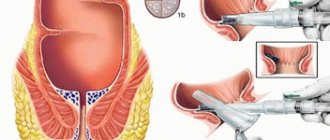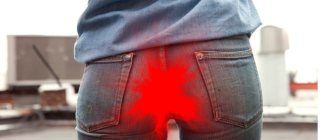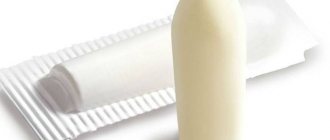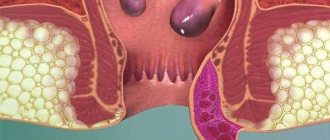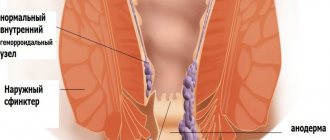Ligation of hemorrhoids with latex rings
An internal hemorrhoid is an enlarged and deformed hemorrhoidal vein that is located inside the rectal canal above the dentate line. The disease brings a lot of suffering to patients, since these altered vessels of the anus periodically become inflamed and are accompanied by pain, bleeding, itching and burning.
From the second stage of hemorrhoids, when the longitudinal muscle of the anal canal loses its tone and elasticity, internal hemorrhoids begin to sag outward through the anal ring. This phenomenon is characterized by severe pain. In addition, various complications may occur, for example, strangulation, thrombosis, or necrosis of prolapsed nodes.
From the moment the nodes begin to fall out, drug therapy effectively eliminates the symptoms of the disease, but cannot completely rid the patient of the disease. Therefore, a number of surgical treatment methods have been developed that are aimed at stopping blood circulation in hemorrhoids, as a result of which they collapse and disappear.
Today, the most popular minimally invasive surgical method for treating hemorrhoids can be called ligation of internal hemorrhoids.
The essence of the method
Ligation of hemorrhoids is the ligation of a hemorrhoid with a latex ring, which stops its blood supply, as a result of which it collapses, dies and comes out after some time naturally (during defecation).
When performing such an intervention, a ligator is used, which is a special endoscopic instrument designed to be inserted into the anus and place rings on the knot.
The ligator can be either mechanical or vacuum. The difference between these instruments is that a vacuum ligator has a system for suctioning fluid from the rectal canal, unlike a mechanical instrument.
Advantages of the method
Bandaging hemorrhoids with latex rings has a number of advantages, namely:
- speed of execution. An experienced specialist will only need 10 minutes to complete this procedure;
- outpatient implementation. Ligation of hemorrhoid cones is carried out in a clinic and does not require hospitalization;
- high efficiency of the method for hemorrhoids stages 2 - 3;
- no general anesthesia required. The intervention is carried out under local anesthesia;
- low-traumatic. During the operation, the specialist does not make any incisions in the tissue of the anus;
- bloodlessness. Since no scalpel is used during the manipulation, the risk of bleeding is eliminated;
- short and easy recovery period. The patient can return to their normal lifestyle the next day.
Disadvantages of the method
Unfortunately, along with the impressive list of advantages of this method, there are also several disadvantages, including the following:
- the method does not eliminate the cause of the disease – venous insufficiency;
- possible recurrence of hemorrhoids after ligation;
- Ligation does not treat external hemorrhoids:
- ineffective for stage 4 hemorrhoids;
- high cost of the method.
But despite some of the disadvantages of ligating hemorrhoids, it still remains popular.
Indications and contraindications
Ligation of internal hemorrhoids is recommended for:
- ineffectiveness of conservative therapy in the early stages of hemorrhoids;
- constant discomfort in the anorectal area;
- prolapse of nodes with impossibility of reduction;
- frequent relapses of pathology;
- life-threatening complications.
There are more contraindications to surgery:
- initial and late stages of hemorrhoids;
- diseases of the blood and coagulation system;
- combined form of pathology;
- tumor growth;
- inflammation of the rectum area with and without cracks;
- proctitis or paraproctitis;
- problems with the cardiovascular system and central nervous system.
The question of the advisability of ligating hemorrhoids with latex rings in each individual case is decided by the doctor after a clinical and laboratory examination of the patient.
Treatment of hemorrhoids with latex rings: list of indications
This operation can be performed at the following stages of the disease:
- first stage of hemorrhoids. Initial hemorrhoids respond well to drug treatment, but this will take some time (1 - 2 weeks). Therefore, when a patient wants to quickly cope with his problem, he can undergo node ligation;
- second - third stages of hemorrhoids. At these stages, ligation with latex rings is most effective;
- fourth stage of hemorrhoids. In advanced forms of the disease, conservative methods, including ligation of nodes, are powerless. The only effective way to treat stage 4 hemorrhoids is radical removal of the nodes. Ring ligation for stage 4 hemorrhoids can be performed in preparation for radical surgery.
Mechanical ligation
The order of procedures when using a mechanical ligature:
- The device is inserted into the anus,
- Using a clamp, the knot is ligated, then it passes through the head of the ligator,
- The doctor starts the mechanism, and the latex thread is thrown onto the neck of the hemorrhoid,
- The place where the ligature was applied is checked - it should not affect the nearest tissues that are located under the serrated edge,
- As a rule, this technique is used for nodes that have clearly visible edges and clear outlines of the legs of the nodes.
The duration of the mechanical operation is a maximum of 10 minutes.
Latex ligation of hemorrhoids: contraindications
Contraindications to ligation of nodes with latex rings are the following:
- inflammation of pararectal tissues;
- acute and chronic proctitis (inflammation of the rectal mucosa);
- external hemorrhoids;
- anal tears;
- neoplasms of the anus;
- the presence of severe concomitant pathology in the patient.
Only a professional proctologist can assess the feasibility of ligating hemorrhoids. The specialist can also anticipate all kinds of complications and minimize all risks to the patient’s health.
Description of the method
Ligation of hemorrhoids - what is it? The foundations of the ligation technique were laid back in the time of Hippocrates, when hemorrhoids were treated by ligating them . The technique became widespread in the 19th century.
However, it was soon abandoned, since the capture of sensitive tissues during ligation of nodes, which occurs due to imperfect technology, led to severe pain in the postoperative period.
Attempts to return to the ligation of hemorrhoids were made in 1958, when the doctor Blaisdell proposed improving the operation by ligating exclusively the tissue of the node itself.
In 1963, a new era of ligation began when a special tool was invented that allowed the ligature to be applied to the knot with precision. At the same time, the use of latex rings began to be used for the operation.
An anoscope currently provides access to nodes for surgeons. A ligator is inserted into it to throw the ring onto the knot.
Due to its ability to stretch and return to its original position, the ring compresses the base of the knot. Impaired blood supply to the affected vessel leads to its deformation and atrophy. After 2-3 weeks, the node dries out and is released from the anus along with feces.
Experts offer at least 5 options for minimally invasive intervention. On our website you can learn about some of them: sclerotherapy, laser coagulation, desarterization.
Preparation for the procedure
The result of treating hemorrhoids with latex rings largely depends on the quality of preparation. In addition, a set of preparatory procedures facilitates the work of the surgeon and reduces the risk of complications.
Preparation for hemorrhoid ligation involves the following:
- diet. 5 - 7 days before surgery, foods that lead to constipation, diarrhea and flatulence are excluded from the patient's diet (chocolate, fatty meats, fish and poultry, fried foods, smoked meats, pickles, marinades, white cabbage, radishes, chocolate, baked goods with fatty creams, etc.), as well as alcoholic drinks;
- a cleansing enema is performed the night before;
- in the morning before ligation, it is necessary to repeat the cleansing enema and wash with warm water and soap, put on clean underwear;
- The procedure is carried out on an empty stomach, so you can drink only clean water without gas.
Also, at a preliminary consultation with the doctor who will perform the ligation of the nodes, you need to inform him about taking any medications - anticoagulants, non-hormonal anti-inflammatory drugs, insulin and others.
Who is not suitable for ligation?
There are strict contraindications to the procedure of pulling hemorrhoids with a latex ligature. Ligation of hemorrhoids with latex rings is not performed if:
- there are combined hemorrhoids - external and internal;
- hemorrhoids are at stage 1 of development - the ligature will come off from small nodules;
- there is no border between the hemorrhoid nodes and the dentate line, as it will be very painful;
- diagnose inflammatory diseases of the lower gastrointestinal tract - anal fissure, proctitis, paraproctitis;
- thrombosis and inflammation of hemorrhoid cones are pronounced;
- infections of the urethra and genital organs were detected;
- helminth infection is present.
Acute hemorrhoids, accompanied by bleeding, pain, burning, itching, are treated conservatively. After the acute stage of the disease has subsided, ligation becomes possible.
Progress of the hemorrhoidal ligation operation with a latex ring
There are two types of ligation of hemorrhoids - vacuum and mechanical.
Let's consider the features of these methods.
Vacuum ligation of hemorrhoids
During the operation, a vacuum ligator with a suction tube is inserted into the anal canal through an anoscope, after which the suction hole is closed with a finger, which allows creating negative pressure. Thus, the varicose hemorrhoidal vein gets inside the ligator, and latex rings are applied to it. After this, the suction hole opens and the instrument is removed from the rectum.
Within a week, the hemorrhoid collapses, dies and comes out with feces.
Vacuum ligation is indicated for unclear boundaries of the hemorrhoid.
Ligation of the hemorrhoid using a mechanical ligator
The anus is dilated using a rectal speculum so that the hemorrhoids can be clearly seen. After this, the doctor inserts a mechanical ligator into the rectum, grabs the nodule with it and places a ring on the hemorrhoid.
Ligation of hemorrhoids is performed under local anesthesia. During the procedure, the patient sits on a proctology chair, with his legs spread to the sides and raised up.
Mechanical ligation is performed only for clearly defined nodes to avoid entrapment of healthy tissue.
Recovery
Rehabilitation after hemorrhoid ligation includes:
- The patient stays under the supervision of a doctor. If no complications arise 1 hour after removing the cones, the patient goes home. The presence of a foreign body in the rectum may be felt for several days.
- Drug therapy. Antibiotics, painkillers and anti-inflammatory drugs are prescribed.
- Following a special diet. The patient who has undergone ligation should eat liquid and semi-liquid food. After a few days, foods containing fiber are introduced into the diet. The amount of fluid consumed is adjusted to 2.5 liters per day.
- Taking laxatives if you have difficulty defecating.
Possible complications and consequences of the procedure
In rare cases, complications may occur during node ligation surgery or during the recovery period, including:
- rectal bleeding;
- pain in the anus;
- falling off of a latex ring from a hemorrhoid;
- thrombosis of nodes;
- anal tears at the site of the fallen node;
- infection of the tissues of the anus.
The complications described above can be associated either with non-compliance with the recommendations of the treating doctor or with incorrect execution of the procedure.
If complications develop after surgery, you must immediately contact your doctor to treat the consequences.
Advantages and disadvantages
People's reviews of the operation are different. Like any other method of surgical treatment of hemorrhoids, ligation of hemorrhoids has its pros and cons. The main ones are presented in the table:
| Benefits of the operation | Disadvantages of Intervention |
| Fast execution (about 20 minutes) | Expensive operation |
| No need for hospital stay | Inability to eliminate the cause of hemorrhoids (problems with the gastrointestinal tract, immunity, cardiovascular system) |
| Return to a normal lifestyle, if the profession does not involve heavy physical labor, immediately after discharge from the clinic | Risk of recurrence of hemorrhoids with repeat surgery |
| Rapid disappearance of symptoms of varicose veins of the rectum, disappearance of pain, itching, burning, bruising | Risk of complications due to tightening of the mucous membranes of the rectum |
Rehabilitation after ligation of hemorrhoids with latex rings
After ligation of hemorrhoids, the patient should follow the following recommendations:
- do not sit on the anus for three days after surgery;
- Limit physical activity for 7 days after the procedure. From the second week of the recovery period, the patient is allowed to engage in swimming, light jogging and walking;
- follow a diet. On the first day, it is forbidden to eat food, you can only drink water. From the second day, the patient’s diet must meet the principles of proper and healthy nutrition;
- Sexual activity is prohibited for two weeks.
During the recovery period, drug therapy is carried out, which helps normalize blood circulation in the vessels of the anus and reduce the risk of relapse. For this, patients are prescribed venotonics and angioprotectors - Detralex, Venarus, Phlebodia 600, Troxevasin or others.
Also, to reduce inflammation in the rectal canal, eliminate pain, prevent bleeding and accelerate tissue restoration, various anti-hemorrhoid suppositories are used (Proctosedyl, Proctosan, Relief, Methyluracil, Ultraproct and others).
Rehabilitation Tips
To reduce the risk of complications and speed up the healing of damaged tissues during the rehabilitation period, you must follow all the advice of your doctor. They relate to limiting physical activity and organizing proper nutrition.
- For several days after ligation of the nodes, the patient is not recommended to remain in a sitting position for a long time. Otherwise, the risk of the latex ring slipping increases, which can lead to bleeding.
- For 30 days you should not engage in heavy physical labor or strength sports (it is generally better to avoid them if you have hemorrhoids). After a week you can swim, run, or do race walking.
- You should remember about daily hygiene procedures. After bowel movement, the anal area is washed with cool water and wiped with a soft cloth. Water can be replaced with chamomile infusion.
Throughout the recovery period, special attention should be paid to preventing constipation. To do this, exclude fastening and gas-forming foods from the diet: legumes, cabbage, cow's milk. Salty, sour, spicy dishes, strong tea and coffee drinks, alcohol and soda are also prohibited.
The patient must monitor the temperature of the food and the method of preparation. You should not eat cold or hot food; the ideal option is warm dishes of a soft consistency, prepared by boiling, baking or stewing.
Pros and cons of the technique
Like all other methods of combating hemorrhoids, the use of latex rings has its positive and negative aspects. They need to be studied before choosing this treatment method.
Advantages of the method:
- The speed of the operation - you only have to wait 15 minutes,
- There is no need to go to the hospital for treatment. If the patient does not face significant physical activity, he can go to work the very next day,
- Such troubles as pain in the anus, bleeding, and the feeling that something is bothering the intestines almost completely disappear.
Of course, ligation is an effective method, but it also has its disadvantages:
- High cost of the procedure,
- The operation does not fight the cause of hemorrhoids, but only its consequences,
- The intestinal lumen may decrease, the mucous membrane tightens, there is a risk of cracks,
- A small risk of new nodes appearing is acceptable.
Recommendations after surgery
| Special recommendations after node ligation | Forbidden |
| 3 times a day - plantain seed after meals, course 30 days. A teaspoon of liquid Vaseline - 2-3 times a day. For severe pain, you can use analgesics: paracetamol + dextropropoxyphene, acetaminophen. Avoid constipation. | Empty your bowels within 24 hours. Do not use aspirin for 14 days. For 30 days it is prohibited to use rectal products and other objects inserted into the anal canal. |
Advice from doctors after the procedure
- It is not recommended to eat a lot immediately after the procedure. Defecation within 24 hours after surgery is not advisable.
- The patient is recommended to rest for a couple of days. It is better to perform the procedure before the weekend. Or apply for sick leave.
- Drug treatment includes analgesics and laxatives.
- It is also advisable to follow a diet! Avoid fatty, spicy, alcohol and foods that cause flatulence.
Sometimes one procedure is not enough, because there may be several hemorrhoids.
In this case, ligation is carried out at intervals of 7-9 days.


